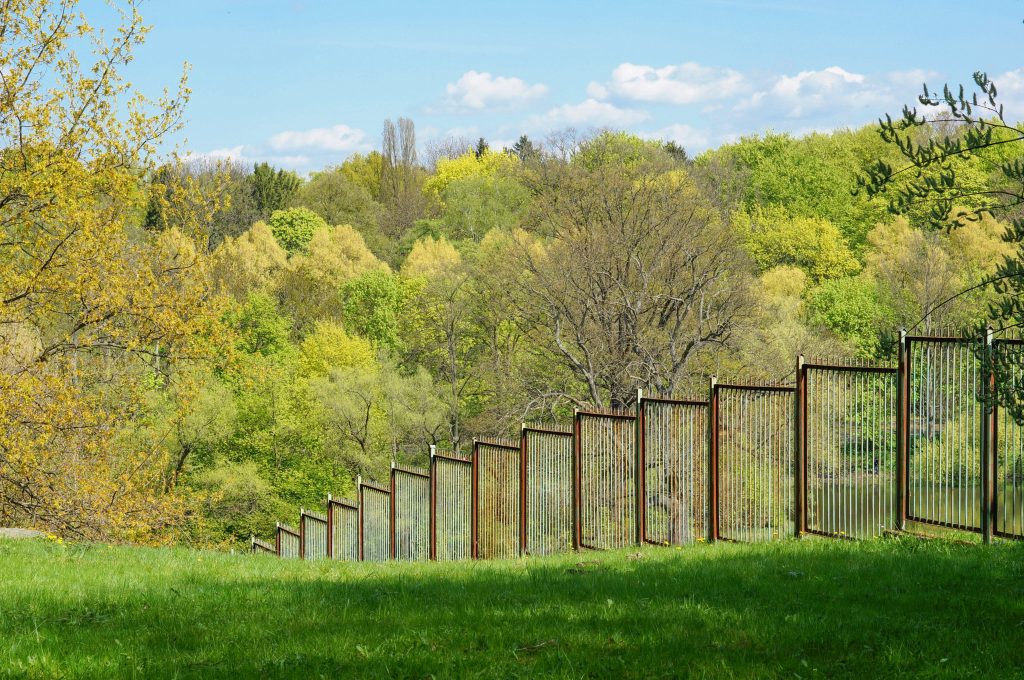Tree staking is a horticultural practice that involves the use of stakes or supports to provide temporary support and stability to young or newly planted trees. The primary purpose of tree staking is to help the tree establish a strong root system and proper upright growth during its initial stages of growth. Staking is typically implemented when a tree is at risk of being toppled over by strong winds, heavy rain, or other environmental factors that could damage its delicate root system or compromise its structural integrity.

Purpose of Tree Staking:
- Wind Protection: Young trees, especially those with a limited root system, are susceptible to being uprooted by strong winds. Tree staking helps anchor the tree and prevents it from being blown over, ensuring its stability until its roots are established enough to anchor it on its own.
- Preventing Lean: Newly planted trees may have a natural lean due to growth conditions or previous nursery practices. Staking can help guide the tree’s growth in an upright position, preventing the development of a permanent lean.
- Reducing Mechanical Stress: Trees that are subject to mechanical stress, such as being bumped or pushed by people or machinery, can benefit from staking to prevent physical damage during their vulnerable early stages.
- Enhancing Root Development: Proper staking techniques encourage the tree’s roots to grow deeper and establish a strong anchor in the soil. This leads to a healthier and more stable tree in the long term.
- Minimizing Soil Compaction: Staking can help reduce soil compaction around the tree’s root zone, allowing for better water infiltration and root expansion.
- Protection Against Wildlife: In some cases, staking can help protect young trees from damage caused by wildlife, such as deer or rabbits, which might otherwise browse on tender branches.
- Support During Weather Extremes: Trees planted in areas prone to severe weather, like heavy rain or snow, may need temporary staking to prevent bending or breakage of branches under the weight of precipitation.
It’s important to note that while tree staking can provide valuable support during a tree’s early years, over-staking or using improper techniques can lead to negative consequences. If staking is used excessively or for too long, it can hinder the development of a strong trunk and root system, making the tree dependent on external support. This is why understanding the appropriate techniques and conditions for tree staking is crucial to ensuring the long-term health and stability of the tree.
In conclusion, tree staking is a practice that involves using temporary support to aid the establishment and growth of young or newly planted trees. Its purpose is to provide stability, protect against external stressors, and promote healthy root and trunk development during the tree’s vulnerable early stages. Properly executed tree staking can lead to healthier, more robust trees that can thrive in their environment for years to come.
Types of Tree Staking Techniques
Understanding different types of tree staking techniques is crucial for ensuring the successful establishment and long-term health of trees. Each tree species, growth stage, and environmental condition may require a specific approach to staking. Properly choosing and implementing the right staking technique can prevent damage, promote natural growth, and prevent over-dependence on external support. Here’s why understanding various tree staking techniques is important:

- Appropriate Support: Different trees have varying growth rates and structures. Understanding different staking methods allows you to choose the appropriate level and type of support needed for a specific tree. This prevents both under-staking, which can lead to instability, and over-staking, which can hinder natural development.
- Preventing Damage: Incorrect staking techniques can cause damage to the tree’s trunk or root system. Knowledge of different methods ensures that the staking process is conducted without harming the tree.
- Strengthening Roots: Proper staking methods encourage the development of a strong root system, which is essential for the tree’s long-term stability. Knowledge of different techniques helps you choose a method that supports root growth.
- Minimizing Stress: Some staking techniques can inadvertently stress the tree if not executed correctly. By understanding different methods, you can choose one that minimizes stress on the tree’s structure and roots.
- Guiding Growth: Certain staking techniques can guide a tree’s growth in a desired direction, preventing the development of a permanent lean or irregular growth patterns. Understanding these methods can help shape the tree’s future form.
- Adapting to Conditions: Different environments and weather conditions require varying staking approaches. By knowing different techniques, you can adapt the staking process to the specific conditions of your location.
- Avoiding Dependency: Over-reliance on staking can lead to weak trunk and root development, making the tree dependent on external support. Proper understanding helps you avoid this issue by knowing when and how to gradually remove staking.
- Long-Term Health: The goal of staking is to promote the tree’s health and stability as it matures. Understanding various techniques ensures that your staking efforts contribute to the tree’s long-term health rather than hindering it.
- Saving Resources: Different staking techniques require different materials and methods. Proper understanding helps you use resources efficiently by selecting the most suitable technique for the tree’s needs.
- Professional Expertise: If you’re working with a professional arborist or landscaper, understanding different staking techniques allows you to have informed discussions and make decisions based on your tree’s specific requirements.
In summary, trees are living organisms that require thoughtful care during their establishment. Understanding different types of tree staking techniques empowers you to choose the right method based on the tree’s species, growth stage, and environmental conditions. This knowledge ensures that your efforts contribute to the tree’s stability, health, and natural growth, setting the foundation for a strong and resilient tree that thrives in its environment.
Types of Tree Staking
There are several common types of tree staking techniques, each with its own advantages, disadvantages, and appropriate use cases. The choice of staking method depends on factors such as tree species, location, soil conditions, and the level of support required. Here are some of the main types of tree staking techniques:

- Single Stake Technique: This method involves driving a single stake into the ground next to the tree and securing the tree to the stake with a tie. The stake should be positioned on the side of the prevailing wind to provide support against bending. This technique is suitable for small to medium-sized trees with a relatively straight central leader.
Advantages:
- Provides stability against wind and bending.
- Minimal material and visibility.
Disadvantages:
- May not provide enough support for larger trees.
- Can cause the tree to grow crooked if not properly aligned.
- Double Stake Technique: In this approach, two stakes are positioned on opposite sides of the tree, and the tree is tied to both stakes. This provides additional stability and prevents the tree from leaning in any direction.
Advantages:
- Offers balanced support to prevent leaning.
- Suitable for larger or top-heavy trees.
Disadvantages:
- Can limit natural movement, which is important for trunk development.
- More visible and may require additional materials.
- Guying Technique: Guying involves using guy wires or cables attached to stakes in the ground to provide support to the tree. This method is particularly useful for trees with heavy canopies or those at risk of uprooting due to their size.
Advantages:
- Distributes support evenly.
- Suitable for larger and top-heavy trees.
- Allows for controlled movement while providing stability.
Disadvantages:
- Requires proper tensioning and adjustment.
- More complex to set up than single or double stakes.
- No-Stake Technique: For certain tree species or conditions, staking might not be necessary. Some trees can develop strong root systems and adapt to environmental conditions without external support.
Advantages:
- Promotes natural trunk and root development.
- Reduces the risk of dependence on staking.
Disadvantages:
- Might not provide adequate support in high-wind areas.
- Young trees can be vulnerable to leaning or bending without support.
It’s important to note that each staking technique should be implemented carefully to avoid damaging the tree’s trunk or root system. Additionally, staking should not be permanent; trees should be gradually weaned from support to encourage healthy trunk and root development.
The choice of staking technique should be based on factors such as the tree’s size, growth stage, location, and environmental conditions. Consulting with a certified arborist or tree care professional can provide valuable insights into which staking method is best suited for a specific tree.
Benefits of Proper Tree Staking for Young or Newly Planted Trees
Proper tree staking for young or newly planted trees offers several benefits that contribute to the tree’s successful establishment, healthy growth, and long-term stability. When done correctly, tree staking provides the necessary support and protection during the tree’s vulnerable early stages. Here are the key benefits of proper tree staking:
- Wind Protection: Young trees with underdeveloped root systems are susceptible to being uprooted or leaning excessively during strong winds. Proper staking prevents wind-induced damage by providing stability and anchoring the tree in place.
- Preventing Leaning or Bending: Staking helps guide the tree’s growth in an upright position, preventing the development of a permanent lean or irregular growth patterns. This ensures that the tree establishes a straight and strong central leader.
- Reduced Risk of Breakage: Properly staked trees are less likely to suffer from breakage of branches or the main stem due to external stressors, such as heavy rain, snow, or accidental bumps.
- Healthy Root Development: Tree staking promotes healthy root growth by preventing excessive movement, which can lead to root disruption or poor root establishment. This is especially important for ensuring a strong foundation for the tree.
- Minimized Soil Compaction: Staking can help prevent soil compaction around the tree’s root zone, allowing for better water infiltration and nutrient exchange, which are essential for healthy growth.
- Enhanced Survival Rates: Properly staked trees have higher survival rates, especially in areas prone to severe weather conditions. Staking provides an added layer of protection during the tree’s most vulnerable stage.
- Uniform Growth and Structure: Staking helps trees grow with a straight trunk and uniform structure. This promotes balanced branching and overall aesthetics.
- Reduced Transplant Shock: Newly planted trees often experience transplant shock as they adapt to their new environment. Proper staking reduces this shock by providing stability and reducing stress on the tree.
- Early Canopy Development: Trees that are properly supported through staking can allocate more energy toward canopy growth and leaf development rather than focusing on regaining stability.
- Prevention of Collar Rot: When staking is done correctly, it ensures that the tree’s lower trunk is not in direct contact with the soil, reducing the risk of collar rot or other fungal diseases.
- Enhanced Aesthetic Appeal: Well-staked trees are visually appealing and contribute to the overall landscape design, making them more attractive to property owners and visitors.
- Long-Term Health and Stability: Proper staking establishes a strong foundation for the tree’s growth, contributing to its overall health and stability as it matures.
It’s important to note that proper tree staking requires careful consideration of factors such as the tree species, size, location, and environmental conditions. Over-staking or using inappropriate techniques can lead to negative outcomes, so seeking advice from certified arborists or tree care professionals is recommended to ensure the best results for young or newly planted trees.
If you need a tree service in Utah, you can call:
Truco Services, Inc.
4640 Commerce Drive
Murray, Utah 84107
(801) 466-8044
https://truetreeservices.com/


Comments are closed.